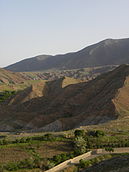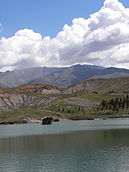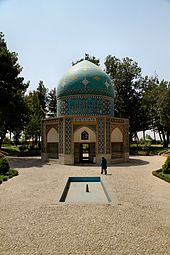নিশাপুর: সংশোধিত সংস্করণের মধ্যে পার্থক্য
Rezwan Khair (আলোচনা | অবদান) ইংরেজি উইকি হতে অনূদিত |
(কোনও পার্থক্য নেই)
|
২১:৪৩, ১০ নভেম্বর ২০১৭ তারিখে সংশোধিত সংস্করণ
| নিশাপুর نیشابور নেশাবুর | |
|---|---|
নিশাপুরের অফিসিয়াল সীলমোহর সীলমোহর | |
| ডাকনাম: সাসানীয় এবং উমাইয়া যুগ: আবরশহর (Upper Cities), Little Damascus (by Ibn Battuta)[১] | |
| স্থানাঙ্ক: ৩৬°১২′৪৮″ উত্তর ৫৮°৪৭′৪৫″ পূর্ব / ৩৬.২১৩৩৩° উত্তর ৫৮.৭৯৫৮৩° পূর্ব | |
| Country | |
| Province | Khorasan |
| County | Nishapur County |
| Foundation | 3rd century |
| Municipality of Nishapur | 1931 |
| সরকার | |
| • Mayor | Seyed Abbas Hosseini |
| • Governor of County | Gholam-Hossein Mozaffari |
| উচ্চতা | ১,২৫০ মিটার (৪,১০০ ফুট) |
| জনসংখ্যা (2011) | |
| • City | ২,৭৬,০৮৯[২] |
| • Nishapur County | ৪,৩৩,১০৫[৩] |
| • Urban areas of Nishapur County | ২,৭০,৩০১ |
| 2 Census | |
| বিশেষণ | Nishapuri |
| সময় অঞ্চল | IRST (ইউটিসি+03:30) |
| ওয়েবসাইট | www |
নিশাপুর বা নিশাবুর (ⓘ; ফার্সি: نیشابور, এছাড়াও রোমান রূপে Nīshāpūr, Nišâpur, Nişapur, Nīshābūr, Neyshābūr, এবং Neeshapoor, যার মূল হলৌ মধ্য -পারসিক শব্দ: New-Shabuhr, অর্থ "শাপুরের নতুন শহর", "সুন্দর শাপুর",[৪] or "শাপুরের নিখুঁত স্থাপত্য")[৫] হলো উত্তরপূর্ব ইরানের খোরাসান প্রদেশের একটি শহর এবং নিশাপুর শহরিস্তানের (বিভাগ) রাজধানী। বিনালুদ পর্বতমালার পাদদেশে অবস্থিত এই শহরটি আগে খোরাসান প্রদেশের রাজধানী ছিল। 2011 সালে এর জনসংখ্যা ছিল আনুমানিক 239,185, এবং পুরো প্রদেশে 433,105। "ফিরোজা ভূমি" বলে অভিহিত এই শহরের আশেপাশে ফিরোজা পাথরের অসংখ্য খনি আছে, যেগুলো প্রায় দুই হাজার বছর ধরে সারা বিশ্বে ফিরোজার যোগান দিচ্ছে।
3য় শতাব্দীতে শাহেনশাহ প্রথম শাপুর এই শহরটি গড়ে তোলেন সাসানীয় একটি সত্রপের রাজধানী হিসেবে। Nishapur later became the capital of Tahirid dynasty and was reformed by Abdullah Tahir in 830, and was later selected as the capital of Seljuq dynasty by Tughril in 1037. From the Abbasid era to the Mongol invasion of Khwarezmia and Eastern Iran, the city evolved into a significant cultural, commercial, and intellectual center within the Islamic world. Nishapur, along with Merv, Herat and Balkh were one of the four great cities of Greater Khorasan and one of the greatest cities in the middle ages, a seat of governmental power in eastern of caliphate, a dwelling place for diverse ethnic and religious groups, a trading stop on commercial routes from Transoxiana and China, Iraq and Egypt.
Nishapur reached the height of its prosperity under the Samanids in the 10th century, but was destroyed by Mongols in 1221, and further ruined by other invasions and earthquakes in the 13th century. After that time, a much smaller settlement was established just north of the ancient town, and the once bustling metropolis lay underground—until a team of excavators from the Metropolitan Museum of Art arrived in the mid-20th century. They worked at Nishapur between 1935 and 1940, returning for a final season in the winter of 1947–48.[৬] What remains of old Nishapur region is a 3500-hectare "Kohandejh" area, south of the current city of Nishapur.
History
এই অনুচ্ছেদটি সম্প্রসারণ করা প্রয়োজন। (July 2017) |
প্রাক-ইতিহাস এবং প্রত্নতত্ত্ব
Little archaeology has been done on this vast and complicated site. George Curzon remarked that Nishapur had been destroyed and rebuilt more times than any other city in history,[৭] an evocative statement whether or not it is statistically true. The Metropolitan Museum of Art undertook excavations from 1935 that were interrupted in 1940. Searching largely for museum-worthy trophies that they shared with the government of the Shah, the Metropolitan's publications were limited to its own Nishapur ceramics. The site of Nishapur has been ransacked for half a century since World War II, to feed the international market demand for early Islamic works of art.
Shadiyakh ("Palace of Happiness") was one of the main palaces of old Nishapur up to the 9th century AD, which became more important and populated after that. Some notable people like Attar lived there. Attar's tomb is nowadays in that area. This palace was perhaps completely ruined in the 13th century.
মধ্যযুগ
Nishapur occupies an important strategic position astride the old Silk Road that linked Anatolia and the Mediterranean Sea with China. On the Silk Road, Nishapur has often defined the flexible frontier between the Iranian plateau and Central Asia. The town derived its name from its reputed founder, the Sassanian king Shapur I, who is said to have established it in the 3rd century CE. Nearby are the turquoise mines that supplied the world with turquoise for at least two millennia.
It became an important town in the Khorasan region but subsequently declined in significance until a revival in its fortunes in the 9th century under the Tahirid dynasty, when the glazed ceramics of Nishapur formed an important item of trade to the west. For a time Nishapur rivaled Baghdad or Cairo: Toghrül, the first ruler of the Seljuk dynasty, made Nishapur his residence in 1037 and proclaimed himself sultan there, but it declined thereafter, as Seljuk fortunes were concentrated in the west. In the year 1000 CE, it was among the ten largest cities on earth.[৮]
After the husband of Genghis Khan's daughter was killed at Nishapur in 1221, she or Genghis ordered the death of the entire population of the city, which was reputedly 1.7 million.[তথ্যসূত্র প্রয়োজন] Their skulls were reputedly piled in pyramids by the Mongols.[তথ্যসূত্র প্রয়োজন] This massacre, combined with subsequent earthquakes destroyed the pottery industry.[তথ্যসূত্র প্রয়োজন]
শিল্প
About the arts in Nishapur or Old Nishapur:
মৃৎশিল্প

Nishapur during the Islamic Golden Age, especially the 9th and 10th centuries, was one of the great centers of pottery and related arts.[৯] Most of the Ceramic artifacts discovered in Nishapur are preserved in the Metropolitan Museum of Art and Museums in Tehran and Mashhad. Ceramics produced at Nishapur showed links with Sassanid art and Central Asian.[১০] Nowadays there are 4 Pottery workshop in Nishapur.[১১]
References
- ↑ The Cambridge History of Iran - Volume 1 - Page 68
- ↑ http://www.sko.ir/Sarshomari1390/Shahrhaye_IRAN.xls
- ↑ http://www.khorasan.ir/LinkClick.aspx?fileticket=lrFSbp8Zxwk%3d&tabid=8771&mid=14529
- ↑ Honigmann, E.; Bosworth, C.E.. "Nīs̲h̲āpūr." Encyclopaedia of Islam, Second Edition. Edited by: P. Bearman, Th. Bianquis, C.E. Bosworth, E. van Donzel, W.P. Heinrichs. Brill Online, 2013. Reference. 31 December 2013
- ↑ নিশাপুর can be found at GEOnet Names Server, at this link, by opening the Advanced Search box, entering "-3076915" in the "Unique Feature Id" form, and clicking on "Search Database".
- ↑ http://www.metmuseum.org/toah/hd/nish/hd_nish.htm
- ↑ George N. Curzon, Persia and the Persian Question, Vol. I, (Routledge, 2005), 262.
- ↑ geography.about.com
- ↑ Nishapur: Pottery of the Early Islamic Period, Wilkinson, Charles K. (1973)
- ↑ http://www.britannica.com/EBchecked/topic/415980/Nishapur-pottery
- ↑ http://incc.ir/fa/Lists/News/DispForm.aspx?ID=2589
Further reading
- Wilkinson, Charles K. (১৯৭৩)। Nishapur: pottery of the early Islamic period। New York: The Metropolitan Museum of Art। আইএসবিএন 0870990764।
External links
- Nishapur Mayors (ফার্সি)
- Nishapur governors (ফার্সি)
- Ceramics of Nishapur and other centers
- আর্কাইভইজে World Gazetteer on Nishapur (২০১২-১২-১৭ তারিখে আর্কাইভকৃত)
- Neyshaburian e-newspaper (ফার্সি)
- A useful weblog about Nishapur (ফার্সি)
- wooden village website
- Nishapur Mathhouse
- Neyshabur bonyad (ফার্সি)
- Elias Pirasteh, Neyshabur, Photo Set, flickr
- Ardavan Ruzbeh, When National Heritage is not an equal to the Emām-Jom'eh, a reportage on the demolition of a national monument, Madreseh-ye Golshan (مدرسه گلشن), in Nishabur, in Persian, Radio Zamāneh, May 29, 2008: Text, Audio.
- Hossein Davoudi, Dizbād: A Staircase to History, in Persian, Jadid Online, 2008.
A Slide Show of Dizbād, by Hossein Davoudi, Jadid Online, 2008, (5 min 39 sec).
Note: Dizbād is a small village between Mashhad and Neyshābūr, located at some 40 km distance from Mashhad.
| পূর্বসূরী - |
Capital of Seljuq Empire (Persia) 1037–1043 |
উত্তরসূরী Rey |









